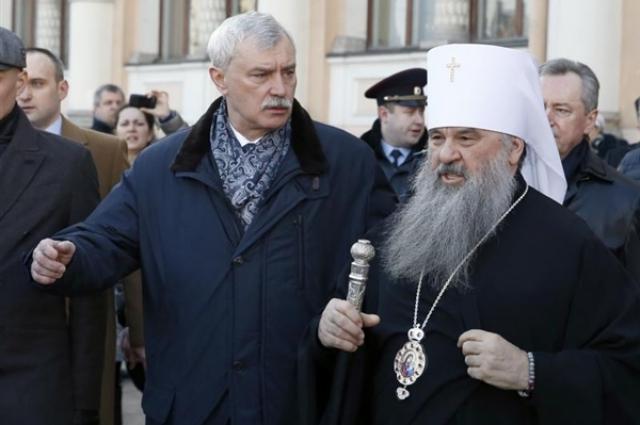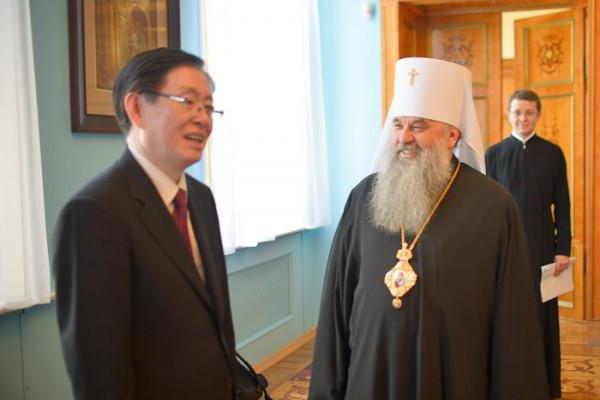Today, among the archpastors of the Russian Orthodox Church there are many true servants of God, whose works revive the faith, trampled upon during the years of atheistic arbitrariness, and the people return to their spiritual sources. These people include the head of the St. Petersburg Metropolis, Metropolitan Barsanuphius (Sudakov).
The childhood and youth of Bishop Barsanuphius
The future archpastor was born on June 3, 1955 in a simple large family living in the village of Malinovka, Saratov Region, and was named Anatoly in holy baptism. In those years when atheism was elevated to the rank of state policy, a child could receive primary religious education only at home. This motherhood was entrusted to him by his mother, Antonina Leontyevna, who did her best to make children faithful followers of the teachings of Christ.
Like most of his peers, Anatoly Sudakov, after graduating from school, worked for a year, waiting for a summons from the military registration and enlistment office, and then, when he finally turned eighteen, he said goodbye to his family and went to serve in the army. A strong and smart country guy was identified in Germany, where he spent two years as a driver of the tank units located in Brandenburg and Potsdam.
From a military overcoat to a monastic cassock
No matter how endless years of service seemed, but they finally ended. Having retired to the reserve and returned home, Anatoly had to solve the main question - which way to choose in life, and what to devote the days allotted to him by the Creator. This is where the abundant seedlings of the Word of God, sown in childhood by his mother, were given. Barely having thrown off his military overcoat, yesterday the tankman put on the clerk’s clerk’s clergyman of the St. Michael’s Archangel Cathedral in Serdobsk, located in the Penza Region.

In 1976, on the advice and blessing of the rector of the cathedral, the servant of God Anatoly, having left a quiet provincial city, went to Moscow, where he entered a theological seminary. Soon, he finally established himself in the decision to devote himself to monastic service, and after spending six months as a novice of the monastery, he accepted monastic tonsure with the name Barsanuphius in honor of the eponymous bishop of Tver, canonized in the face of the saints. From now on, the day of his namesake was April 24 - the day of remembrance of the holy saint of God.
The beginning of spiritual ascent
Immediately after being tonsured as a monk, Metropolitan Barsanuphius began to ascend the steps of the church hierarchy. A month later he was ordained to the rank of hierodeacon, and after another six months in the hieromonk. After that, until 1982, he served as an assistant sacristan.
In these years, his efficiency and perseverance were surprisingly manifested. Having set himself the goal of receiving a spiritual education, Abbot Barsanuphius, without interrupting his basic duties, managed to graduate from the seminary in three years, instead of four, which allowed him to enter the Moscow Theological Academy in 1982 .
In the circle of wise mentors
Fulfilling the obediences entrusted to him in the Trinity-Sergius Lavra, the future Metropolitan Barsanuphius in his writings relied on the advice of wise mentors. Among them were the confessors of the laurels, Archimandrite Naum and Cyril, the viceroy of the laurels, Archimandrite Eusebius (Savvin) and many other persons who shared their spiritual experience with him.
He also had to closely communicate with the future patriarch of all Russia, and in those years Metropolitan of Tallinn and Estonia Alexy (Ridiger). Hegumen Barsanuphius met with him, and even served him repeatedly on visits to the Pühtitsky convent in Estonia, where he regularly visited on vacation time.
Subsequent Ministry and Consecration to Bishop
Years of study at the Theological Academy ended with the defense of a dissertation, after which the newly made candidate of theology was appointed to the city of Kuznetsk in the Penza region, where he spent almost two years as rector of the local Kazan Church. The next place of his ministry was the Assumption Cathedral of the city of Penza.
The bishop's ministry, to which the graduate of the Theological Academy has steadily moved over the past few years, dates back to 1991. Then, by the decision of the Holy Synod, a significant territory was allocated from the Penza diocese , which became an independent administrative-church unit, and was called the Saransk diocese. Archimandrite Barsanuphius was entrusted with leading it, and in the light of this decision adopted by the patriarch, on February 8 of the same year he was ordained bishop. A week later, Vladyka arrived at the place of his new ministry.
Bishop's ministry in the entrusted diocese
The rich experience of the diocesan administration, which Metropolitan Barsanuphius of St. Petersburg and Ladoga has behind him today, laid the foundation precisely in the newly formed Saransk diocese. Thanks to his tireless efforts, more than two hundred new parishes and fourteen monasteries appeared on the territory of the region. In addition, a seminary was opened under the care of the Bishop, and a number of religious publications were published. Evaluation of his work was the elevation to the rank of archbishop, completed in February 2001.
At that time, the St. Petersburg Metropolitanate was headed by Metropolitan Vladimir (Kotlyarov), whose successor was destined to become Bishop Barsanuphius. Vladyka closely cooperated with him in the working group created by the Holy Synod to develop a document formulating the position of the Russian Orthodox Church on issues of interreligious relations.
The elevation to the rank of Metropolitan
The next important stage on the path of the hierarchal ministry of the Vladyka was his appointment to the post of administrator of the Moscow Patriarchate, and approval as a permanent member of the Secretary of the Holy Synod. In connection with February 1, 2010, Archbishop Barsanuphius was elevated to the rank of Metropolitan by a patriarchal decree.
A year earlier, he was instructed to head the Prize Commission, created shortly before this under the Patriarch of Moscow and All Russia. Metropolitan Barsanuphius fulfilled this honorable duty until 2013.
Creation of new dioceses
The service of Metropolitan Barsanuphius as the head of the Saransk diocese was marked by the creation of two new church-administrative formations. They became the Krasnoslobodskaya and Ardatovsk dioceses. Guided by a deep knowledge of the specifics of the work entrusted to him, Vladyka repeatedly pointed out that in order to carry out effective administration, no more than one hundred and fifty parishes should be subordinate to the diocesan bishop, since a greater number of them complicates careful and consistent leadership.
His initiative was approved by the members of the Holy Synod and entailed corresponding structural changes. Then Metropolitan Barsanuphius was appointed interim head of the newly created Mordovian Metropolis.
At the head of the St. Petersburg diocese
In March 2014, an event occurred that became a significant milestone in the life of Metropolitan Barsanuphius - by the decision of the Holy Synod he was determined to take the vacant position of the head of the St. Petersburg and Ladoga diocese. Having replaced his predecessor at this post - Metropolitan Vladimir (Kotlyarov), Barsanuphius of St. Petersburg - this is what he was called from this time on, with his inherent energy he set about arranging the affairs entrusted to him.

The St. Petersburg Metropolis is a complex and responsible area of work. It was established in 1742 and during the synodal period, in the absence of the patriarch, was considered the first in honor and seniority in the Russian Orthodox Church. Until 1783, it had the status of a diocese, but then after its then head, Archbishop Gabriel (Petrov) was elevated to the rank of metropolitan, it became known as the metropolis. In the subsequent historical period, it retained this name, since it was always headed by the metropolitans.
This status was officially fixed by the decision of the Local Council of 1917-1918, but a quarter of a century later abolished. In its current form, the metropolis was formed by the decision of the Holy Synod, which met in March 2013, and a year later it was headed by Metropolitan Barsanuphius of St. Petersburg and Ladoga.
Active ministry of the Church
Vladyka is the author of numerous publications that saw the light both on the pages of periodicals and as separate publications. Among them are works on theology and church history, as well as appeals to the flock, related to specific topical issues.
In addition, the head of the St. Petersburg Metropolitanate often becomes a participant in various television and radio programs in which he gives interviews, acquainting the general public with his views on the most significant aspects of the religious, political and economic life of the country. The reception room of Metropolitan Barsanuphius often becomes the site of impromptu press conferences held for representatives of various media.
Today, Vladyka Barsanuphius is sixty-one years old, but despite this, he is full of strength and energy. There is no doubt that no matter what place of worship the Lord may have prepared for him, he will always remain His faithful slave and worthy son of the Russian Orthodox Church.